Citation: Scheitel M, Stanic M, Neuberger M. PM10, PM2.5, PM1, number and surface of particles at the child’s seat when smoking a cigarette in a car[J]. AIMS Environmental Science, 2016, 3(4): 582-591. doi: 10.3934/environsci.2016.4.582
| [1] | Nikolaos Barmparesos, Vasiliki D. Assimakopoulos, Margarita Niki Assimakopoulos, Evangelia Tsairidi . Particulate matter levels and comfort conditions in the trains and platforms of the Athens underground metro. AIMS Environmental Science, 2016, 3(2): 199-219. doi: 10.3934/environsci.2016.2.199 |
| [2] | Jordan Finch, Daniel W. Riggs, Timothy E. O’Toole, C. Arden Pope III , Aruni Bhatnagar, Daniel J. Conklin . Acute exposure to air pollution is associated with novel changes in blood levels of endothelin-1 and circulating angiogenic cells in young, healthy adults. AIMS Environmental Science, 2019, 6(4): 265-276. doi: 10.3934/environsci.2019.4.265 |
| [3] | Tabaro H. Kabanda . Investigating PM2.5 pollution patterns in South Africa using space-time analysis. AIMS Environmental Science, 2024, 11(3): 426-443. doi: 10.3934/environsci.2024021 |
| [4] | Andrea L. Clements, Matthew P. Fraser, Pierre Herckes, Paul A. Solomon . Chemical mass balance source apportionment of fine and PM10 in the Desert Southwest, USA. AIMS Environmental Science, 2016, 3(1): 115-132. doi: 10.3934/environsci.2016.1.115 |
| [5] | Ernyasih, Anwar Mallongi, Anwar Daud, Sukri Palutturi, Stang, Abdul RazakThaha, Erniwati Ibrahim, Wesam Al Madhoun, Andriyani . Strategy for mitigating health and environmental risks from vehicle emissions in South Tangerang. AIMS Environmental Science, 2023, 10(6): 794-808. doi: 10.3934/environsci.2023043 |
| [6] | Barend L. Van Drooge, David Ramos García, Silvia Lacorte . Analysis of organophosphorus flame retardants in submicron atmospheric particulate matter (PM1). AIMS Environmental Science, 2018, 5(4): 294-304. doi: 10.3934/environsci.2018.4.294 |
| [7] | K. Wayne Forsythe, Cameron Hare, Amy J. Buckland, Richard R. Shaker, Joseph M. Aversa, Stephen J. Swales, Michael W. MacDonald . Assessing fine particulate matter concentrations and trends in southern Ontario, Canada, 2003–2012. AIMS Environmental Science, 2018, 5(1): 35-46. doi: 10.3934/environsci.2018.1.35 |
| [8] | Carolyn Payus, Siti Irbah Anuar, Fuei Pien Chee, Muhammad Izzuddin Rumaling, Agoes Soegianto . 2019 Southeast Asia Transboundary Haze and its Influence on Particulate Matter Variations: A Case Study in Kota Kinabalu, Sabah. AIMS Environmental Science, 2023, 10(4): 547-558. doi: 10.3934/environsci.2023031 |
| [9] | Suwimon Kanchanasuta, Sirapong Sooktawee, Natthaya Bunplod, Aduldech Patpai, Nirun Piemyai, Ratchatawan Ketwang . Analysis of short-term air quality monitoring data in a coastal area. AIMS Environmental Science, 2021, 8(6): 517-531. doi: 10.3934/environsci.2021033 |
| [10] | Meher Cheberli, Marwa Jabberi, Sami Ayari, Jamel Ben Nasr, Habib Chouchane, Ameur Cherif, Hadda-Imene Ouzari, Haitham Sghaier . Assessment of indoor air quality in Tunisian childcare establishments. AIMS Environmental Science, 2025, 12(2): 352-372. doi: 10.3934/environsci.2025016 |
A high number of Austrian citizens are exposed to second-hand smoke (SHS) compared to other European countries. Non-smokers and minors are exposed to tobacco smoke (in workplaces, public places, home and in motor vehicles) more frequently than the EU average [1,2]. Intake of toxic and carcinogenic volatile organic compounds from SHS in motor vehicles have been previously studied[3]. However, when investigating acute effects of SHS on children, exposures to fine and ultrafine particles are more important. Existing research has shown how vehicle speed, window position and ventilation [4] can lead to large variation of exposure to PM2.5 [5]. Much less is known about exposures to PM1, ultrafine particle number (PN) and lung deposited surface area (LDSA), which we studied simultaneously with PM2.5 in standardized conditions designed to simulate a typical journey to school or kindergarten.
Studies show that children exposed to SHS are at higher risk of illnesses such as respiratory infections [6,7], cardiovascular diseases [8,9], food allergies [10], mental illnesses such as depression and sleeping disorders [11], cancer [12] and sudden infant death syndrome [13,14]. Whilst the role of ultrafine particles in these associations is still unknown, previous research in this field has focused on estimating exposure to PM2.5 rather than PN [14] and LDSA [15]. To our knowledge no study has measured LDSA on the child’s seat in relation to cigarette smoking.
Nine percent of all smokers in Europe consume tobacco products in cars in the attendance of children. In Austria this is higher with 16 percent of the smokers confessing to do so in 2006 [16].
For each scenario three return journeys on a fixed route from a suburban domestic area to a school were taken in a KIA Cee’d CRDI 1.6 motion SW (2009). This was designed to simulate a typical ten minute school commute.
An adult was smoking in the front passenger seat, while another drove. The smoker lit the cigarette during the first minute of the trip. In scenario 2 and scenario 3 the cigarette was placed near the opened window while smoking, in contrast to scenario 1 where the cigarette was smoked inside the car.
In scenario 0 two journeys without smoking were taken in advance to assess the background pollution inside the car while driving. These data were used for the statistic analysis (Table 1).
| Scenarios | Cigarette close to passenger window | Number of cigarettes smoked | Cigarette was smoked on the |
| Scenario 0 | - | 0 | - |
| Scenario 1 | No | 1 | way to school |
| Scenario 2 | Yes | 1 | way to school |
| Scenario 3 | Yes | 2 | way to school and back |
In all scenarios the front passenger window remained two inches open, with all other windows closed. The climate-control fan inside the car was turned off at all times. After the destination was reached, the back door on the passenger’s side was opened for ten seconds, simulating exit or entering of child, before the return journey under the same conditions.
The air quality was monitored by two devices: A miniature diffusion size classifier“minidisc”(Matter Aerosol), model G3_016 and by a laser-spectrometer and optical particle counter, model 1.108 (Grimm), which were fixed using a child’s car safety seat at approximately the height of a child’s nose (Figure 1). With these two devices the concentrations of the following parameters were recorded: PM1, PM2.5 and PM10 of particles larger than 300 nm, and number and LDSA of ultrafine particles (10-300 nm).
 Figure 1. Photo of equipment setup inside the car at the backseat on the passenger’s side.
Figure 1. Photo of equipment setup inside the car at the backseat on the passenger’s side.Nineteen public monitoring stations quantify ambient fine particulates on a daily data basis in Vienna. These facilities collect data on PM10 and PM2.5 every half an hour and were used to get an idea of the outdoor concentrations during the scenarios. Because higher background concentrations of PM10 and PM2.5 were observed on the day of scenario 1, the indoor exposures were also compared to the indoor baseline before lighting a cigarette.
Concentrations of PM10, PM2.5 and PM1 for each scenario are shown in Figures 2-5. For statistical analysis the following exposure times were distinguished: baseline (first minute of trip, before cigarette lit), smoking of first cigarette, after smoking, opening of backdoor (red line) and the return journey partitioned in 2 phases. As scenario 2 and scenario 3 had the same conditions during the way to school, the two scenarios were summarised for the statistical analysis and marked as scenario 2/3.
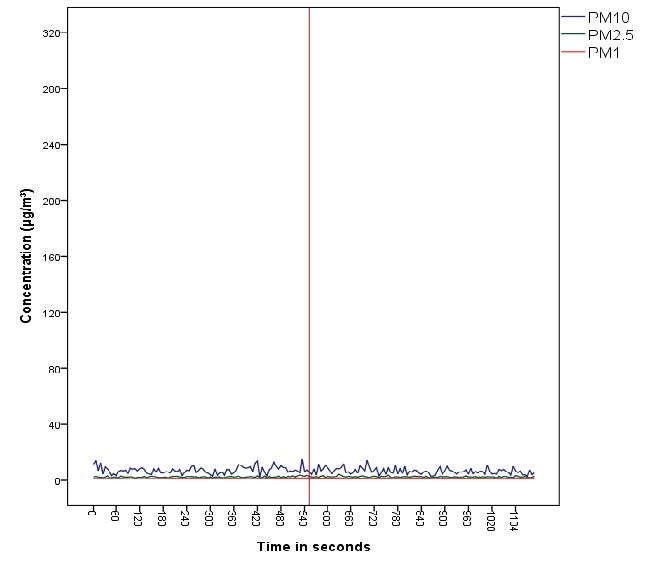 Figure 2. Average levels of PM10, PM2.5 and PM1 measured in scenario 0 (background).
Figure 2. Average levels of PM10, PM2.5 and PM1 measured in scenario 0 (background).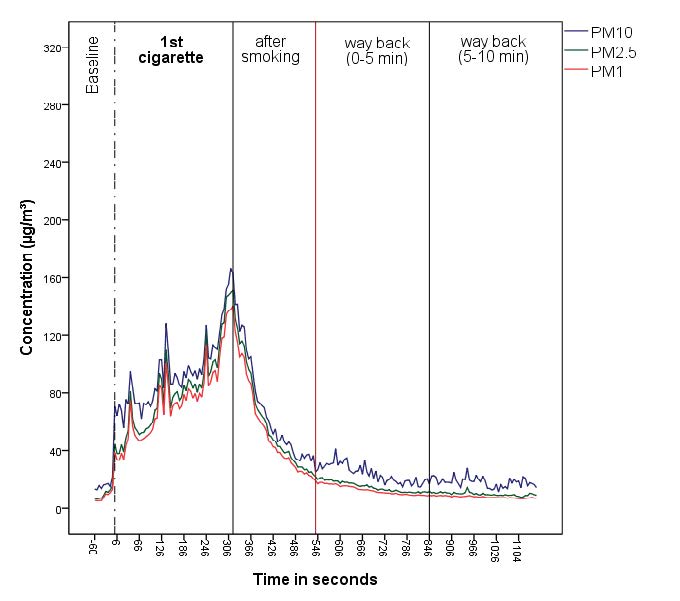 Figure 3. Average levels of PM10, PM2.5 & PM1 measured in scenario 1 where single cigarette was smoked during outward journey. There was a significant increase of PM10, PM2.5 and PM1 until the 8th minute of return journey compared to scenario 0.
Figure 3. Average levels of PM10, PM2.5 & PM1 measured in scenario 1 where single cigarette was smoked during outward journey. There was a significant increase of PM10, PM2.5 and PM1 until the 8th minute of return journey compared to scenario 0.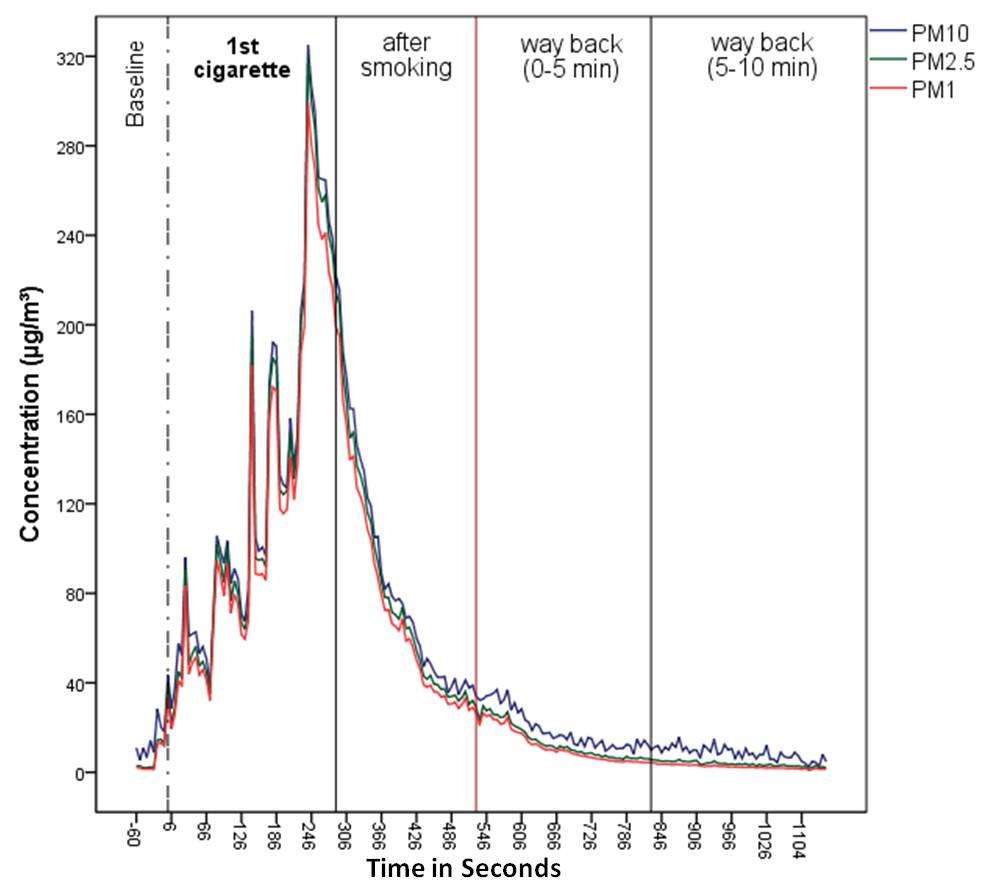 Figure 4. Average levels of PM10, PM2.5 & PM1 measured in scenario 2 where single cigarette was smoked on outward journey and held near the window. There was a significant increase of PM10, PM2.5 and PM1 until the 8th minute of return journey.
Figure 4. Average levels of PM10, PM2.5 & PM1 measured in scenario 2 where single cigarette was smoked on outward journey and held near the window. There was a significant increase of PM10, PM2.5 and PM1 until the 8th minute of return journey. Figure 5. Average levels of PM10, PM2.5 & PM1 measured in scenario 3 where a cigarette was smoked both during outward and return journeys and held near window. There was a significant increase of PM10, PM2.5 and PM1 on both outward and return journeys.
Figure 5. Average levels of PM10, PM2.5 & PM1 measured in scenario 3 where a cigarette was smoked both during outward and return journeys and held near window. There was a significant increase of PM10, PM2.5 and PM1 on both outward and return journeys.One single cigarette smoked during a simulated 10 minute journey from home to school, lead to a significant increase of PM10 (scenario 0: I: p 0.007; II/III: p 0.004; baseline: I: p 0.032), PM2.5 (scenario 0: I: p 0.01; II/III: p < 0.001; baseline: I: p 0.023) and PM1 (scenario 0: I: p 0.008; II/III:p < 0.001; baseline: I: p 0.023) in all scenarios during the outward journey in comparison to scenario 0 and the baseline for each journey.
There remained a significant increase of PM10 (I: p < 0.001; II: p 0.004), PM2.5 (I: p 0.003; II:p0.009) and PM1 (I: p 0.002; II: p 0.036) in scenario 1 and scenario 2 until minute 8 of the return journey in comparison to scenario 0. Compared to the baseline there was a significant increase of PM10 in scenario 1 for the first 2 minutes of the way back home.
Concentrations of PM10, PM2.5 and PM1 dropped after opening the back door, but remained elevated on the return journey in comparison to low outdoor concentrations. Holding the cigarette near the open window of the front passenger seat, did not reduce exposure on the back seat. A mean increase of PM10 by a factor of 10.5, for PM2.5 by a factor of 21.3 and for PM1 by a factor of 23.9 was detected, while smoking a cigarette in the front seat (Table 2). When a second cigarette was smoked on the return journey, concentrations rose again to comparable levels as before.
| Average (µg m-3) | scenario 0 | scenario 1 | scenario 2 | scenario 3 | |
| baseline | PM10 | 7.4 | 15.4 | 12.3 | 28.2 |
| PM2.5 | 2.4 | 9.2 | 5.8 | 9.9 | |
| PM1 | 1.4 | 7.6 | 4.8 | 7.5 | |
| 1st cigarette | PM10 | - | 94 | 129.6 | 104.1 |
| PM2.5 | - | 80.4 | 123.3 | 93.9 | |
| PM1 | - | 73.7 | 114.8 | 86.2 | |
| after smoking | PM10 | - | 68.9 | 85.6 | 54 |
| PM2.5 | - | 61.2 | 79.3 | 46.9 | |
| PM1 | - | 55.9 | 73.3 | 42.5 | |
| 2nd baseline | PM10 | - | - | - | 28.1 |
| PM2.5 | - | - | - | 16.6 | |
| PM1 | - | - | - | 14.4 | |
| 2nd cigarette | PM10 | - | - | - | 129.3 |
| PM2.5 | - | - | - | 120.2 | |
| PM1 | - | - | - | 111.2 | |
| way back (0–5 min) | PM10 | - | 24.7 | 18.7 | - |
| PM2.5 | - | 15.3 | 12.8 | - | |
| PM1 | - | 12.9 | 11 | - | |
| way back (5–10 min) | PM10 | 6.3 | 18.1 | 8.9 | 51.1 |
| PM2.5 | 2.5 | 9.9 | 3.8 | 43.1 | |
| PM1 | 1.5 | 7.8 | 2.5 | 39.2 |
The highest concentration of Ultrafine Particles, at almost 10 times higher than scenario 0, was found in scenario 3 (153,498 ptcm−3), where two cigarettes were smoked. But even one single cigarette smoked (Scenario 1: 97,701 pt cm−3and scenario 2: 90,796 pt cm−3) contaminated the air in the car significantly compared to scenario 0 (Table 3). Similar to the PM analysis the high ultrafine particle numbers decayed continuously after the cigarettes were burnt down. In the scenarios with one cigarette smoked, particle number concentrations reached background concentrations at the end of the return journey. The time course of LDSA was similar (Figure 6).
| LDSA (µm2 cm-3) | Ultrafine Particles (pt cm-3) | ||
| scenario 0 | Mean | 38.4 | 15,545 |
| Maximum | 10 | 3690 | |
| Minimum | 81 | 31,362 | |
| scenario 1 | Mean | 270 | 97,701 |
| Maximum | 27 | 11,205 | |
| Minimum | 937 | 401,026 | |
| scenario 2 | Mean | 231.9 | 90,796 |
| Maximum | 15 | 6446 | |
| Minimum | 998 | 411,197 | |
| scenario 3 | Mean | 383.9 | 153,498 |
| Maximum | 15 | 6830 | |
| Minimum | 862 | 418,616 |
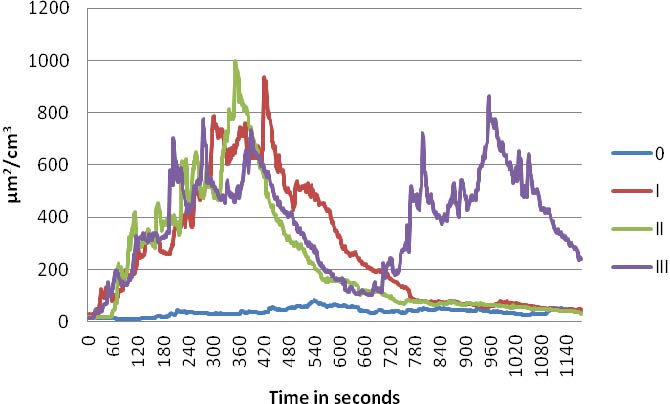 Figure 6. Lung deposited surface area (LDSA) concentrations of all scenarios.
Figure 6. Lung deposited surface area (LDSA) concentrations of all scenarios.Figures 6 and 7 show that in scenario 1 there was a longer duration of high particle number concentration and LDSA incomparison to scenario 2 and 3, although the maxima were similar. An explanation could be that the faster airstream caused by smoking closer to the open window led to a faster burning of the cigarettes in scenario 2 and 3. In scenario 1 the mean smoking duration was 5.3 minutes and in the other scenarios 4.7 minutes, however, due to the small number of measurements taken this difference was not statistically significant.
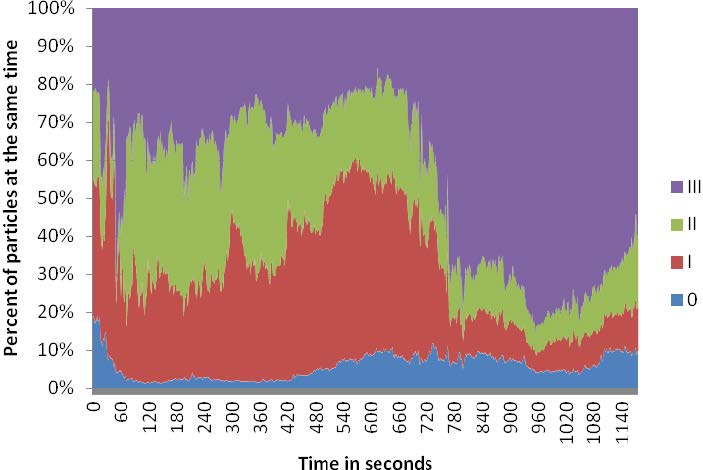 Figure 7. Fractions of particle number concentrations from all scenarios at the progressed time. Prolonged high levels are seen in scenario 1, when the cigarette was smoked inside the car, in comparison to scenario 2 where the cigarette was smoked next to the window.
Figure 7. Fractions of particle number concentrations from all scenarios at the progressed time. Prolonged high levels are seen in scenario 1, when the cigarette was smoked inside the car, in comparison to scenario 2 where the cigarette was smoked next to the window.The correlation between LDSA and particle number was highly significant: Spearman’s rank correlation coefficient between 0.95 and 0.996, p < 0.0001. The total amount of LDSA accumulated over the return journey, of approximately 20 minutes duration, was in scenario 1 (21.6 mm2), scenario2 (18.6 mm2) and scenario 3 (30.7 mm2).
This study shows that a single cigarette smoked in a car, even with the window opened, lead to an alarming increase of fine particle mass and ultrafine particle number and surface, which is in agreement with results of former studies [17,18].
There were slightly lower averages of PM10, PM2.5 and PM1 concentrations found in scenario 1, when the cigarette was smoked inside the car, than in scenario 2 and scenario 3 where the cigarette was held near the window (Table 2). This unexpected result confirms earlier observations of higher averages when holding a cigarette outside the car [5,19].Under similar conditions Edwards et al. [19] have found a mean concentration of PM2.5 of 162 µg m−3 when the cigarette smoked was held outside compared to 119 µg m−3 when the cigarette was held inside the car.
Sohn et al. [20] investigated the effect of the window opening conditions on PM2.5 and UFP while smoking in a moved car. PM2.5 levels stayed elevated even after a 15 minute ride with the driver’s window 4 inches open, while UFP levels reduced to the baseline levels in 10 minutes, independently of the opening of the driver's window (fully, half or 4 inches open) [5,20].
Private family cars are one of the most frequent areas where exposure to SHS happens. A survey of 12,269 adults in England in 2014 revealed that 77 percent of the people, 63 percent of them active smokers, supported legislation that bans smoking under the presence of children in the car[21].
One single cigarette smoked in a moving car, with the passenger’s window open, exposes other passengers and especially children to elevated particle concentrations in the fine (0.3-2.5 µm) and ultrafine (10-300 nm) size range. This may pose threats to health. On the child’s car safety seat there was an increase of PM2.5 and PM1 by the factor of 21.3 and 23.9 compared to background concentrations before the cigarette was lit. Holding the cigarette to the 2 inches open window did not prevent an increase of PM2.5/PM1/PN/LDSA to 123.3 µg m−3/114.8 µg m−3/90,796 pt cm−3/231.9 mm2 m−3 on the outward journey. Some contamination remained on return journey, but when a second cigarette was lit, PN concentration reached 153,498 pt cm−3 on the child’s car safety seat. This paper also shows that the common belief that, smoking near an open window reduces concentration of toxic fine particles within the vehicle, is incorrect.
This work was performed as diploma thesis at the Medical University of Vienna. Apparatus was provided by the Commission of Climate & Air Quality of the Austrian Academy of Science.
All authors declare no conflicts of interest in this paper.
| [1] | European Commission, Attitudes of Europeans towards tobacco and electronic cigarettes-Factsheet Austria, 2015. Available from: http://ec.europa.eu/public_opinion/archives/eb_special_439_420_en.htm#429. |
| [2] | TNS Opinion & Social, Eurobarometer Special 385, 2012. Available from: http://ec.europa.eu/health/tobacco/docs/eurobaro_attitudes_towards_tobacco_2012_en.pdf. |
| [3] |
St.Helen G, Jacob P, Peng M, et al. (2014) Intake of toxic and carcinogenic volatile organic compounds from secondhand smoke in motor vehicles. Cancer epidem biomar 23: 2774-2782. doi: 10.1158/1055-9965.EPI-14-0548

|
| [4] |
Ott W, Klepeis N, Switzer P (2008) Air change rates of motor vehicles and in-vehicle pollutant concentrations from secondhand smoke. J Expo Sci Environ Epidemiol 18: 312-325. doi: 10.1038/sj.jes.7500601

|
| [5] |
Raoof SA, Agaku IT, Vardavas CI (2015) A systematic review of secondhand smoke exposure in a car: Attributable changes in atmospheric and biological markers. Chron Respir Dis 12: 120-131. doi: 10.1177/1479972315575202

|
| [6] | U.S. Environmental Protection Agency, Fact Sheet: Respiratory Health Effects of Passive Smoking. Washington, DC, EPA/600/6-90/006F, 1992. Available from: http://ofmpub.epa.gov/eims/eimscomm.getfile?p_download_id=36793. |
| [7] | Li JS, Peat JK, Xuan W, et al. (1999) Meta-analysis on the association between environmental tobacco smoke (ETS) exposure and the prevalence of lower respiratory tract infection in early childhood. Pediatr Pulmonol 27: 5-13. |
| [8] | Kallio K, Jokinen E, Saarinen M, et al. (2010) Arterial Intima-Media Thickness, Endothelial Function, and Apolipoproteins in Adolescents Frequently Exposed to Tobacco Smoke. Circ Cardiovasc Qual Outcomes 3: 196-203. |
| [9] | Department of Health and Human Service (2006) The Health Consequences of Involuntary Exposure to Tobacco Smoke: A Report of the Surgeon General. Atlanta, GA: US Department of Health and Human Services, Centers for Disease Control and Prevention, Coordinating Center for Health Promotion, National Center for Chronic Disease Prevention and Health Promotion, Office on Smoking and Health, 2006, 709. |
| [10] | Lannero E, Wickman M, van Hage M, et al. (2008) Exposure to environmental tobacco smoke and sensitisation in children. Thorax 63: 172-176. |
| [11] |
Shiue I (2014) Modeling the effects of indoor passive smoking at home, work, or other households on adult cardiovascular and mental health: the Scottish Health Survey, 2008–2011. Int J Environ Res Public Health 11: 3096-3107. doi: 10.3390/ijerph110303096

|
| [12] | American Cancer Society, Health Risks of Secondhand Smoke, 2015. Available from: http://www.cancer.org/cancer/cancercauses/tobaccocancer/secondhand-smoke. |
| [13] |
Wisborg K, Kesmodel U, Henriksen TB, et al. (2000) A prospective study of smoking during pregnancy and SIDS. Arch Dis Child 83: 203-206. doi: 10.1136/adc.83.3.203

|
| [14] | Particles H, Understanding the Health Effects of Ambient Ultrafine Particles. HEI Perspectives, 2013, 32013. |
| [15] | Geiss O, Bianchi I, Barrero-Moreno J (2016) Lung-deposited surface area concentration measurements in selected occupational and non-occupational environments. J Aerosol Sci 96: 24-37. |
| [16] | Eurobarometer S, Attitudes of Europeans towards Tobacco, TNS Opinion Social, 2006. Available from: http://ec.europa.eu/public_opinion/archives/ebs/ebs_272c_en.pdf. |
| [17] |
Liu S, Zhu Y (2010) A case study of exposure to ultrafine particles from secondhand tobacco smoke in an automobile. Indoor Air 20: 412-423. doi: 10.1111/j.1600-0668.2010.00665.x

|
| [18] |
Rees VW, Connolly GN (2006) Measuring air quality to protect children from secondhand smoke in cars. Am J Prev Med 31: 363-368. doi: 10.1016/j.amepre.2006.07.021

|
| [19] | Edwards R, Wilson N, Pierse N (2006) Highly hazardous air quality associated with smoking in cars: New Zealand pilot study. N Z Med J 119: U2294. |
| [20] |
Sohn H, Lee K (2010) Impact of smoking on in-vehicle fine particle exposure during driving. Atmos Environ 44: 3465-3468. doi: 10.1016/j.atmosenv.2010.06.006

|
| [21] | Action on smoking and health (2016) Smoking in cars. Available from: http://www.ash.org.uk/files/documents/ASH_714.pdf. |
| 1. | Cindy DeForest Hauser, Ronnae Mailig, Hannah Stadtler, Jenna Reed, Shi Chen, Emilie Uffman, Karen Bernd, Waterpipe tobacco smoke toxicity: the impact of waterpipe size, 2020, 29, 0964-4563, s90, 10.1136/tobaccocontrol-2019-054960 | |
| 2. | Liqiao Li, Yan Lin, Tian Xia, Yifang Zhu, Effects of Electronic Cigarettes on Indoor Air Quality and Health, 2020, 41, 0163-7525, 363, 10.1146/annurev-publhealth-040119-094043 | |
| 3. | Georg Strasser, Stefan Hiebaum, Manfred Neuberger, Commuter exposure to fine and ultrafine particulate matter in Vienna, 2018, 130, 0043-5325, 62, 10.1007/s00508-017-1274-z | |
| 4. | M. Neuberger, Innenluft und Passivrauch, 2018, 15, 1613-5636, 254, 10.1007/s10405-018-0183-9 | |
| 5. | Lukas Pitten, Dörthe Brüggmann, Janis Dröge, Markus Braun, David A. Groneberg, TAPaC—tobacco-associated particulate matter emissions inside a car cabin: establishment of a new measuring platform, 2022, 17, 1745-6673, 10.1186/s12995-022-00359-x | |
| 6. | Liqiao Li, Yifang Zhu, 2022, Chapter 7-1, 978-981-10-5155-5, 1, 10.1007/978-981-10-5155-5_7-1 | |
| 7. | Liqiao Li, Yifang Zhu, 2022, Chapter 7, 978-981-16-7679-6, 199, 10.1007/978-981-16-7680-2_7 | |
| 8. | Irene Possenti, Silvano Gallus, Alessandra Lugo, Anna Mar López, Giulia Carreras, Raquel Fernández-Megina, Adrián González-Marrón, Giuseppe Gorini, Helena Koprivnikar, Efstathios Papachristou, Angeliki Lambrou, Sotiria Schoretsaniti, Melinda Pénzes, Dolors Carnicer-Pont, Esteve Fernández, Best practices for secondhand smoke and secondhand aerosol protection and evidence supporting the expansion of smoke and aerosol-free environments: Recommendations from the 2nd Joint Action on Tobacco Control, 2024, 10, 2459-3087, 1, 10.18332/tpc/193147 |
| Scenarios | Cigarette close to passenger window | Number of cigarettes smoked | Cigarette was smoked on the |
| Scenario 0 | - | 0 | - |
| Scenario 1 | No | 1 | way to school |
| Scenario 2 | Yes | 1 | way to school |
| Scenario 3 | Yes | 2 | way to school and back |
| Average (µg m-3) | scenario 0 | scenario 1 | scenario 2 | scenario 3 | |
| baseline | PM10 | 7.4 | 15.4 | 12.3 | 28.2 |
| PM2.5 | 2.4 | 9.2 | 5.8 | 9.9 | |
| PM1 | 1.4 | 7.6 | 4.8 | 7.5 | |
| 1st cigarette | PM10 | - | 94 | 129.6 | 104.1 |
| PM2.5 | - | 80.4 | 123.3 | 93.9 | |
| PM1 | - | 73.7 | 114.8 | 86.2 | |
| after smoking | PM10 | - | 68.9 | 85.6 | 54 |
| PM2.5 | - | 61.2 | 79.3 | 46.9 | |
| PM1 | - | 55.9 | 73.3 | 42.5 | |
| 2nd baseline | PM10 | - | - | - | 28.1 |
| PM2.5 | - | - | - | 16.6 | |
| PM1 | - | - | - | 14.4 | |
| 2nd cigarette | PM10 | - | - | - | 129.3 |
| PM2.5 | - | - | - | 120.2 | |
| PM1 | - | - | - | 111.2 | |
| way back (0–5 min) | PM10 | - | 24.7 | 18.7 | - |
| PM2.5 | - | 15.3 | 12.8 | - | |
| PM1 | - | 12.9 | 11 | - | |
| way back (5–10 min) | PM10 | 6.3 | 18.1 | 8.9 | 51.1 |
| PM2.5 | 2.5 | 9.9 | 3.8 | 43.1 | |
| PM1 | 1.5 | 7.8 | 2.5 | 39.2 |
| LDSA (µm2 cm-3) | Ultrafine Particles (pt cm-3) | ||
| scenario 0 | Mean | 38.4 | 15,545 |
| Maximum | 10 | 3690 | |
| Minimum | 81 | 31,362 | |
| scenario 1 | Mean | 270 | 97,701 |
| Maximum | 27 | 11,205 | |
| Minimum | 937 | 401,026 | |
| scenario 2 | Mean | 231.9 | 90,796 |
| Maximum | 15 | 6446 | |
| Minimum | 998 | 411,197 | |
| scenario 3 | Mean | 383.9 | 153,498 |
| Maximum | 15 | 6830 | |
| Minimum | 862 | 418,616 |
| Scenarios | Cigarette close to passenger window | Number of cigarettes smoked | Cigarette was smoked on the |
| Scenario 0 | - | 0 | - |
| Scenario 1 | No | 1 | way to school |
| Scenario 2 | Yes | 1 | way to school |
| Scenario 3 | Yes | 2 | way to school and back |
| Average (µg m-3) | scenario 0 | scenario 1 | scenario 2 | scenario 3 | |
| baseline | PM10 | 7.4 | 15.4 | 12.3 | 28.2 |
| PM2.5 | 2.4 | 9.2 | 5.8 | 9.9 | |
| PM1 | 1.4 | 7.6 | 4.8 | 7.5 | |
| 1st cigarette | PM10 | - | 94 | 129.6 | 104.1 |
| PM2.5 | - | 80.4 | 123.3 | 93.9 | |
| PM1 | - | 73.7 | 114.8 | 86.2 | |
| after smoking | PM10 | - | 68.9 | 85.6 | 54 |
| PM2.5 | - | 61.2 | 79.3 | 46.9 | |
| PM1 | - | 55.9 | 73.3 | 42.5 | |
| 2nd baseline | PM10 | - | - | - | 28.1 |
| PM2.5 | - | - | - | 16.6 | |
| PM1 | - | - | - | 14.4 | |
| 2nd cigarette | PM10 | - | - | - | 129.3 |
| PM2.5 | - | - | - | 120.2 | |
| PM1 | - | - | - | 111.2 | |
| way back (0–5 min) | PM10 | - | 24.7 | 18.7 | - |
| PM2.5 | - | 15.3 | 12.8 | - | |
| PM1 | - | 12.9 | 11 | - | |
| way back (5–10 min) | PM10 | 6.3 | 18.1 | 8.9 | 51.1 |
| PM2.5 | 2.5 | 9.9 | 3.8 | 43.1 | |
| PM1 | 1.5 | 7.8 | 2.5 | 39.2 |
| LDSA (µm2 cm-3) | Ultrafine Particles (pt cm-3) | ||
| scenario 0 | Mean | 38.4 | 15,545 |
| Maximum | 10 | 3690 | |
| Minimum | 81 | 31,362 | |
| scenario 1 | Mean | 270 | 97,701 |
| Maximum | 27 | 11,205 | |
| Minimum | 937 | 401,026 | |
| scenario 2 | Mean | 231.9 | 90,796 |
| Maximum | 15 | 6446 | |
| Minimum | 998 | 411,197 | |
| scenario 3 | Mean | 383.9 | 153,498 |
| Maximum | 15 | 6830 | |
| Minimum | 862 | 418,616 |